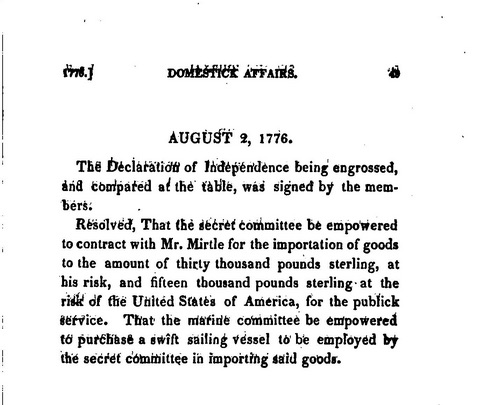Founding-Documents Blog Series: Part Two
Between now and July 4th, my blog features an ongoing series related to the history and signing of the Declaration of Independence…
. . . . . . . . . . . . . . . . . . . . . . . . . . . . . .
When Did Congress Sign the Declaration?
In Part One of this series, I described the Declaration as a contract. Just as we would when signing a contract today, in 1776 Congress tried to get all the parties (congressmen) into the same room on the same day to sign it—witnesses to one another. The date they chose for everyone to reassemble in Philadelphia was August 2nd, 1776.
The Issues of Assembling in 1776
When mail takes between 2–4 weeks to deliver, and you’re fighting a war with an army already on your soil, getting everyone to return to Philadelphia is a chore. Additionally, the distance imposed limits. Today I can drive from Richmond to Williamsburg in about 45 minutes, but in 1776 it could take up to 3 days–dependent on horse, carriage, and/or weather. If I’m not feeling well, I’d send my regrets, just as Richard Henry Lee did.
Today I can drive from Richmond to Williamsburg in about 45 minutes, but in 1776 it could take up to 3 days–dependent on horse, carriage, and/or weather.
How many Congressmen were in Philadelphia on August 2nd, 1776?
Let’s look at numbers. In the end, 56 men signed the Declaration. There were just 55 until November of 1776, when New Hampshire elected Matthew Thornton (topic for the next post…). Of those original 55, evidence suggests there were between 49 or 50 at the formal event. All of Congress except Richard Henry Lee, George Wythe, Lewis Morris, Oliver Wolcott, Thomas McKean, Matthew Thornton, and Elbridge Gerry.
While the latter, Gerry, is generally thought to have signed it later in the fall, in a post about the signing by J.M. Bell in his blog Boston 1775, he recounts a wild story told about the signing in which Benjamin Harrison IV saying to Gerry that, “I shall have a great advantage over you Mr. Gerry when we are all hung for what we are now doing. From the size and weight of my body I shall die in a few minutes, but from the lightness of your body you will dance in the air an hour or two before you are dead.” Fictions aside…
Did Congress Record who signed the Declaration?
Well, that would have made writing my book all the easier! Alas, while Congress often listed individual names for voting records in their meeting minutes, the August 2nd entry in their journal showed only this.

Reader Insider Note: This same historical entry from Congress’ “Secret Journals,” page 53, helped me craft bits of fiction for Carrying Independence. The passage is included on page 80 of the novel, and when I first discovered the entry, I used it to determine:
• The name, “Mirtle,” as a surname pseudonym for my protagonist, Nathaniel.
• How much Nathaniel would be paid for his task—30,000 pounds.
• A sailing vessel, the Frontier captained by Hugo Blythe featured in this excerpt, would take Nathaniel north to Manhattan.
. . . . . . . . . . . . . . . . . . . . . . . . . . . . . .
For more history nerd posts like these, subscribe to the blog. Guest posts are welcomed and encouraged. Contact me for details.
For behind-the-scenes author-related news, giveaways, and to find out where I might be speaking near you, subscribe to my e-publication, CHASING HISTORIES.
